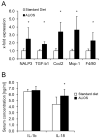IL-18 but Not IL-1 Signaling Is Pivotal for the Initiation of Liver Injury in Murine Non-Alcoholic Fatty Liver Disease
- PMID: 33202693
- PMCID: PMC7696705
- DOI: 10.3390/ijms21228602
IL-18 but Not IL-1 Signaling Is Pivotal for the Initiation of Liver Injury in Murine Non-Alcoholic Fatty Liver Disease
Abstract
Non-alcoholic fatty liver disease (NAFLD) is rising in prevalence, and a better pathophysiologic understanding of the transition to its inflammatory phenotype (NASH) is key to the development of effective therapies. To evaluate the contribution of the NLRP3 inflammasome and its downstream effectors IL-1 and IL-18 in this process, we applied the true-to-life "American lifestyle-induced obesity syndrome" (ALiOS) diet mouse model. Development of obesity, fatty liver and liver damage was investigated in mice fed for 24 weeks according to the ALiOS protocol. Lipidomic changes in mouse livers were compared to human NAFLD samples. Receptor knockout mice for IL-1 and IL-18 were used to dissect the impact of downstream signals of inflammasome activity on the development of NAFLD. The ALiOS diet induced obesity and liver steatosis. The lipidomic changes closely mimicked changes in human NAFLD. A pro-inflammatory gene expression pattern in liver tissue and increased serum liver transaminases indicated early liver damage in the absence of histological evidence of NASH. Mechanistically, Il-18r-/-- but not Il-1r-/- mice were protected from early liver damage, possibly due to silencing of the pro-inflammatory gene expression pattern. Our study identified NLRP3 activation and IL-18R-dependent signaling as potential modulators of early liver damage in NAFLD, preceding development of histologic NASH.
Keywords: ALiOS; NAFLD; NASH; NLRP3; Western diet; inflammasome; interleukin 1; interleukin 18.
Conflict of interest statement
GD received fees for advisory boards, teaching and lectures and travel support from AbbVie, Falk, Gilead, GMP Orphan, Intercept and Novartis. EdT received lecture fees from BMS and Falk Pharma, serves as a consultant to AstraZeneca, Bayer, BMS, EISAI, Eli Lilly, Pfizer, IPSE and Roche, has received research funding from Arqule, AstraZenece, BMS, Bayer, Eli Lilly and Roche and has been reimbursed by Arqule, AstraZenece, BMS, Bayer, Celsion and Roche for attending conferences. All other authors report no conflict of interest.
Figures




References
MeSH terms
Substances
Grants and funding
LinkOut - more resources
Full Text Sources
Medical
Miscellaneous

